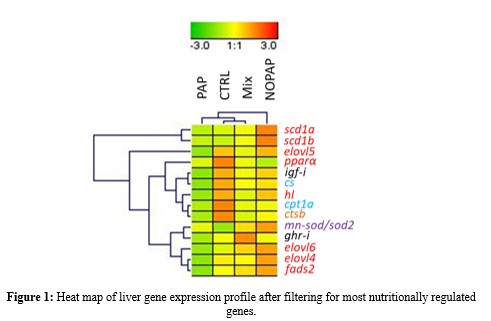GROWTH PERFORMANCE AND LIVER GENE EXPRESSION IN SEABREAM Sparus aurata FED ECO-EFFICIENT AQUAFEEDS
Introduction
New emerging ingredients have risen in recent years in order to follow the world shift towards sustainable aquaculture. These alternative ingredients (e.g., insect products, by-products of fisheries, aquaculture and animal production, bacterial biomasses and algae-based products) tend to replace those commonly used up to date (e.g. fish meal, fish oil, soybean meal) due to sustainability issue s (Gasco et al., 2018, Oswald et al., 2019) . The results here presented show what effects on performance and fish metabolism may be expected when formulations based on emerging ingredients are used in gilthead seabream. This work is part of the GAIN project (H2020 grant 773330, European Union) which aims to develop a new generation of sustainable fish feeds specifically designed to facilitate aquaculture eco-intensification through increased circularity and resource utilization.
Material and Methods
G rowth performance and liver gene expression was assessed in Sparus aurata fed with four different diets : 1) a control diet containing fish meal and traditional soy products (CTRL); 2) a diet rich in processed animal proteins derived from farm animal by-products (PAP); 3) a diet with alternative ingredients without the inclusion of PAP (NoPAP ); and 4) a diet containing a mixture of alternative ingredients (MIX). This nutritional trial was performed with four replicates, each one with 55 fish with an initial weight of 30g, at a temperature of 22±0.35ºC, during 9 weeks. Liver samples were analyzed by PCR-array for expression of 42 genes.
Results
At the end of the trial, no statistical differences were found in final body weight (FBW), relative growth rate (RGR) and voluntary feed intake (VFI). However, fish fed control diet showed higher protein efficiency ratio (PER), when compared to fish fed with other formulations. Additionally, fish fed with control and NoPAP diets presented a lower feed conversion ratio (FCR) when compared with fish fed PAP and MIX diets. When comparing between groups, the NoPAP group showed up-regulation of lipid metabolism-related genes (elovl6 , fads2 , scd1a , and scd1b ) and downregulation of the lipolytic transcription factor pparα, when compared to the control group (Figure 1). In contrast, fish fed PAP diet presented down-regulation of performance-related genes (ghr-i , igf-i), lipid metabolism-related genes (elovl4 , elovl5 , scd1a , fads2 and hl ) and antioxidant defence-related genes (cpt1a and cs ).
Discussion and Conclusions
The increased expression of scd , fads2 and elovl6 enzymes in NOPAP group is a typical characteristic feature of a reduced supply of n-3 LC-PUFA. On the other hand, t he hepatic expression of fish fed the PAP diet was mostly opposite with a marked down-regulated expression of elongases (elovl4, elovl5), having PUFA as main substrates . Therefore, the new sustainable formulations tested in this trial did not affect much the fish growth performance, but liver gene expression suggests several adaptations to the different feed formulations, in particular for lipid metabolism, GH/IFG system and antioxidant defence. Taking together these results the PAP diet may lead to lower performance in the long-term.
References
Gasco, L., Gai, F., Maricchiolo, G., Genovese, L., Ragonese, S., Bottari, T., Caruso, G., 2018. Fishmeal Alternative Protein Sources for Aquaculture Feeds, in: Gasco , L., Gai, F., Maricchiolo , G., Genovese, L., Ragonese , S., Bottari , T., Caruso, G. (Eds.), Feeds for the Aquaculture Sector: Current Situation and Alternative Sources, SpringerBriefs in Molecular Science. Springer International Publishing, Cham, pp. 1–28. https://doi.org/10.1007/978-3-319-77941-6_1
Oswald, A. T., Ishikawa, M., Koshio , S., Yokoyama, S., Moss, A. S., & Serge, D. (2019). Nutritional evaluation of Nannochloropsis powder and lipid as alternative to fish oil for kuruma shrimp, Marsupenaeus japonicus. Aquaculture, 504, 427-436.
